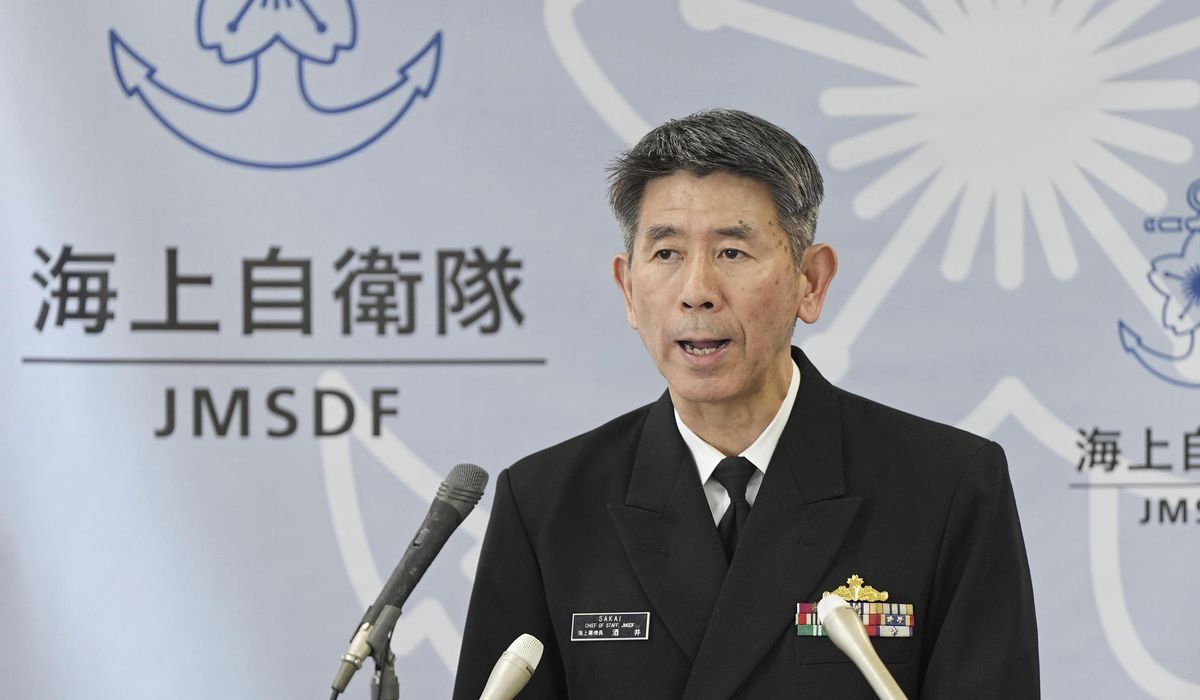


SEOUL, South Korea – The leader of Japan’s powerful navy, the Maritime Self-Defense Force, announced his resignation Friday after multiple members of his force were punished for professional failings.
Friday’s news is just the latest to shake the JMSDF.
It broke just one day after it was revealed that a JMSDF captain is facing an official probe after his destroyer strayed into Chinese territorial waters last week.
And it came three months after a deadly JMSDF helicopter crash.
According to Japanese press reports Friday, 218 members of the Self-Defense Forces have been punished with dismissals, demotions, suspensions, pay cuts and reprimands.
Most of the punishments were handed out to members of the JMSDF, the reports stated. Malpractices include mishandling of classified information, abuse of power and fraudulently claiming specialist pay.
Prime Minister Fumio Kishida and Defense Minister Minoru Kihara made separate public apologies, and JMSDF Chief of Staff Adm. Ryo Sakai resigned.
“In the midst of an extremely severe security environment surrounding Japan … there were incidents which have greatly undermined the public’s expectations and trust in the JMSDF including improper management of classified information and allowance fraud,” Adm. Sakai wrote in a statement.
“As Chief of Staff, I am acutely aware of my responsibility for the misconduct,” Adm. Sakai added.
Just one day earlier, Japanese officials revealed that a JMSDF destroyer captain is facing an investigation after his vessel, the Suzutsuki, intruded into Chinese territorial waters near Taiwan on July 4, sparking a behind-the-scenes diplomatic dispute.
The 5,000-ton warship, which was shadowing Chinese fleet units engaged in drills, maneuvered closer than 12 nautical miles to China’s Zhejiang coastal province and cruised in the area for 20 minutes before departing, Kyodo News reported, citing unnamed diplomatic sources.
The day prior to the incident, China had declared a no-sail zone in the area as a prelude to a live-fire exercise.
Beijing conveyed “serious concern” to Tokyo over the incident, Kyodo reported. In informal talks between the two sides, Japanese officials raised the possibility that it was a “procedural error” by the crew.
Per Google maps, Zhejiang lies northwest of Taiwan and is the closest Chinese province to a disputed set of uninhabited Islands in the East China Sea. The flashpoint Senkakus are administered by Japan, but claimed by China, which calls them the Diaoyu.
When it comes to right of “innocent passage” through territorial waters, it is a legal gray area whether that right extends to warships, Kyodo wrote.
Chinese coast guard vessels regularly intrude into what Japan considers its territorial waters, around the Senkaku/Diaoyus.
In its report Friday on punishments meted out to service personnel, the Japan Times wrote, “Crew members on several MSDF destroyers allegedly shared sensitive classified information by tasking unqualified colleagues with recording vessel movements.”
It is unclear if that issue may have contributed to last week’s intrusion off coastal Zhejiang.
The latest revelations follow an April disaster in which two JMSDF helicopters crashed, leading to the deaths of eight personnel.
Adm. Sakai called it an “irreparable loss as well as a greatest regret to the JMSDF.”
At a time when the U.S. Navy is facing global overstretch while China massively builds up its naval muscle, the JMSDF is widely considered a potent force. Western military personnel in the region consider it to be the cream of Japan’s Self-Defense Forces (SDF).
Though it lacks nuclear-powered or armed vessels, the JMSDF fields two F-35 capable “helicopter destroyers” – de-facto light aircraft carriers – and eight Aegis destroyers.
It is noted for anti-submarine and anti-mine capabilities, while its surface escort force is larger than that of the British and French navies’ escort arms, combined.
However impressive its hardware may be, the JMSDF suffers software issues.
Though Japan is a strategically situated archipelagic nation that lies east of China and northeast of Taiwan, experts say the JMSDF is poor at interoperating with its counterpart air and ground forces.
And all three Japanese forces are facing, like the volunteer armed forces of prosperous liberal democracies including the U.K. and U.S., challenges recruiting and retaining personnel.
• Andrew Salmon can be reached at asalmon@washingtontimes.com.
